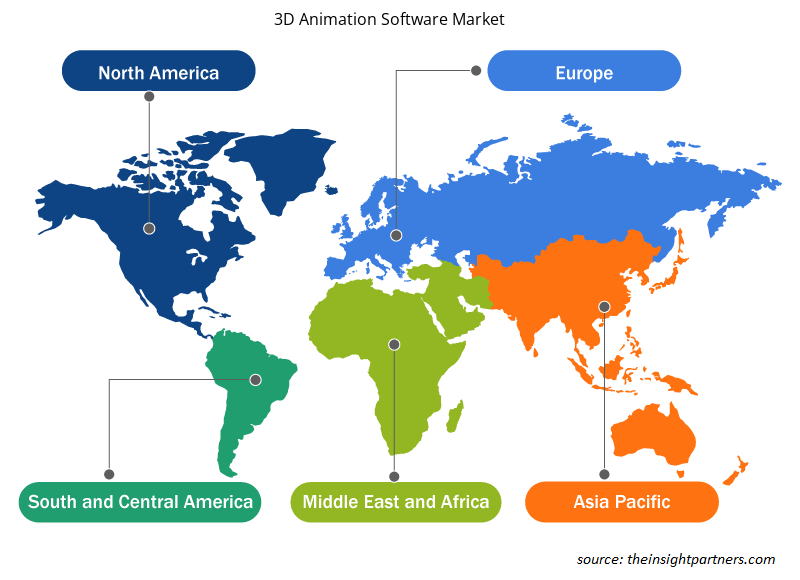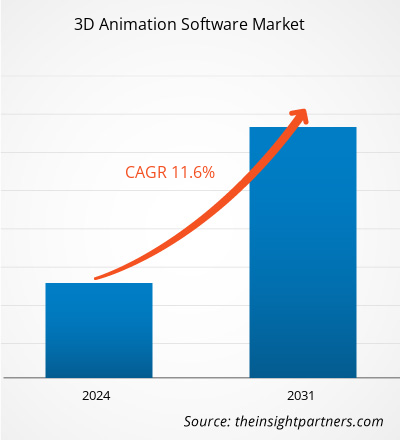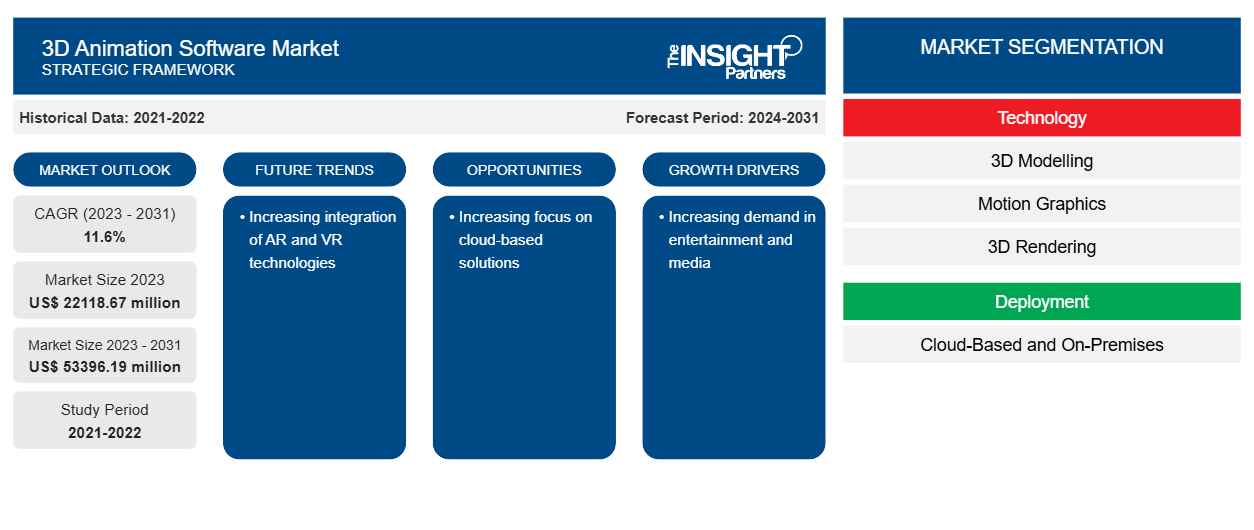Si prevede che la dimensione del mercato del software di animazione 3D raggiungerà i 53.396,19 milioni di dollari entro il 2031, rispetto ai 22.118,67 milioni di dollari del 2023. Si prevede che il mercato registrerà un CAGR dell'11,6% nel periodo 2023-2031. È probabile che la crescente integrazione delle tecnologie AR e VR rimanga una tendenza chiave nel mercato.
Analisi di mercato del software di animazione 3D
I principali fattori che guidano la crescita del mercato del software di animazione 3D includono la tendenza in via di sviluppo della realtà virtuale (VR) e dell'intelligenza artificiale (AI) e la crescente domanda di app e giochi mobili 3D. Inoltre, significativi progressi tecnologici e un maggiore utilizzo del software di animazione per scopi educativi e accademici stanno stimolando la crescita del mercato del software di animazione 3D. Il rapporto sul mercato del software di animazione 3D fornisce uno studio dettagliato di vari fattori trainanti e tendenze future che contribuiscono alla proliferazione del mercato del software di animazione 3D.
Panoramica del mercato del software di animazione 3D
Il software di animazione 3D è un programma di immagini generate al computer (CGI) per visualizzare, generare e modificare immagini e animazioni 3D statiche e dinamiche. Attraverso numerose tecnologie, come effetti visivi (VFX), modellazione 3D , grafica animata e rendering 3D, il programma fonde filmati e immagini artificiali per creare oggetti e situazioni realistici. Viene spesso utilizzato per generare effetti creativi in spot pubblicitari e promozioni di prodotti, visualizzare informazioni scientifiche, di prodotto e di sistema ed eseguire analisi visive. Ha diverse applicazioni in settori quali media e intrattenimento, architettura, sanità e scienze della vita.
Personalizza questo report in base alle tue esigenze
Riceverai la personalizzazione gratuita di qualsiasi report, comprese parti di questo report, o analisi a livello nazionale, pacchetto dati Excel, oltre a usufruire di grandi offerte e sconti per start-up e università
- Scopri le principali tendenze di mercato in questo rapporto.Questo campione GRATUITO includerà analisi di dati che spaziano dalle tendenze di mercato alle stime e alle previsioni.
Driver e opportunità del mercato del software di animazione 3D
Crescente domanda di intrattenimento e media
Il software di animazione 3D è ampiamente utilizzato come software di animazione 3D di riferimento nei settori dei giochi, dei film e dei media e dell'intrattenimento. Questi strumenti di animazione supportano sia flussi di lavoro poligonali che di scultura. L'animazione dei personaggi è uno dei suoi punti di forza principali, grazie alle sue funzionalità per il rigging e l'animazione keyframe. Supporta anche l'input da software di motion capture, rendendolo un favorito per i team che hanno bisogno di catturare movimenti altamente realistici per i personaggi. Pertanto, la domanda di tale software è in aumento nell'intrattenimento e nei media.
Maggiore attenzione alle soluzioni basate sul cloud
Diverse aziende stanno prendendo iniziative strategiche per lanciare software di animazione 3D basati su cloud, come partnership, acquisizioni, ecc. Ad esempio, a maggio 2024, Autodesk, Inc. ha annunciato di aver acquisito Wonder Dynamics, creatori di Wonder Studio, una soluzione di animazione 3D e VFX basata su cloud che combina l'intelligenza artificiale (AI) con strumenti consolidati. Allo stesso modo, ad aprile 2024, lo specialista australiano del settore VFX e della post-produzione Andreas Wanda ha lanciato Atmos, un nuovo studio di animazione e VFX basato su cloud che fornisce servizi di soluzioni di post-produzione completamente da remoto per film trasmessi, televisione e contenuti online. Pertanto, la crescente adozione di veicoli elettrici sta creando maggiori opportunità per il mercato.
Analisi della segmentazione del rapporto di mercato del software di animazione 3D
I segmenti chiave che hanno contribuito alla derivazione dell'analisi di mercato del software di animazione 3D sono tecnologia, distribuzione e applicazione.
- In base alla tecnologia, il mercato del software di animazione 3D è suddiviso in modellazione 3D, grafica animata, rendering 3D, effetti visivi (VFX) e altri. Il segmento delle soluzioni ha detenuto una quota di mercato maggiore nel 2023.
- In base all'implementazione, il mercato è segmentato in cloud-based e on-premises. Il segmento cloud ha detenuto una quota di mercato maggiore nel 2023.
- In base al materiale di applicazione, il mercato è segmentato in media e intrattenimento, sanità e scienze della vita, produzione, istruzione e ricerca e altri.
Analisi della quota di mercato del software di animazione 3D per area geografica
L'ambito geografico del rapporto sul mercato del software di animazione 3D è suddiviso principalmente in cinque regioni: Nord America, Asia Pacifico, Europa, Medio Oriente e Africa, Sud e Centro America.
Il Nord America deteneva la quota di mercato più grande per i software di animazione 3D. La crescita del mercato in questa regione è attribuita all'aumento dell'utilizzo di tecnologie all'avanguardia nei settori sanitario e delle scienze biologiche, dei media e dell'intrattenimento e dell'istruzione e dell'accademia. Il crescente utilizzo di effetti visivi in film, applicazioni mobili e giochi contribuisce al mercato dei software di animazione 3D nel Nord America.
Approfondimenti regionali sul mercato del software di animazione 3D
Le tendenze regionali e i fattori che influenzano il mercato del software di animazione 3D durante il periodo di previsione sono stati ampiamente spiegati dagli analisti di Insight Partners. Questa sezione discute anche i segmenti del mercato del software di animazione 3D e la geografia in Nord America, Europa, Asia Pacifico, Medio Oriente e Africa e Sud e Centro America.

- Ottieni i dati specifici regionali per il mercato del software di animazione 3D
Ambito del rapporto di mercato del software di animazione 3D
| Attributo del report | Dettagli |
|---|---|
| Dimensioni del mercato nel 2023 | 22118,67 milioni di dollari USA |
| Dimensioni del mercato entro il 2031 | 53396,19 milioni di dollari USA |
| CAGR globale (2023-2031) | 11,6% |
| Dati storici | 2021-2022 |
| Periodo di previsione | 2024-2031 |
| Segmenti coperti | Per tecnologia
|
| Regioni e Paesi coperti | America del Nord
|
| Leader di mercato e profili aziendali chiave |
|
Densità dei player del mercato del software di animazione 3D: comprendere il suo impatto sulle dinamiche aziendali
Il mercato del software di animazione 3D sta crescendo rapidamente, spinto dalla crescente domanda degli utenti finali dovuta a fattori quali l'evoluzione delle preferenze dei consumatori, i progressi tecnologici e una maggiore consapevolezza dei vantaggi del prodotto. Con l'aumento della domanda, le aziende stanno ampliando le loro offerte, innovando per soddisfare le esigenze dei consumatori e capitalizzando sulle tendenze emergenti, il che alimenta ulteriormente la crescita del mercato.
La densità degli operatori di mercato si riferisce alla distribuzione di aziende o società che operano in un particolare mercato o settore. Indica quanti concorrenti (operatori di mercato) sono presenti in un dato spazio di mercato in relazione alle sue dimensioni o al valore di mercato totale.
Le principali aziende che operano nel mercato del software di animazione 3D sono:
- Adobe
- Autodesk Inc.
- Società Corel
- EIAS3D
- Maxon Corporation GmbH
- Effetti collaterali
Disclaimer : le aziende elencate sopra non sono classificate secondo un ordine particolare.

- Ottieni una panoramica dei principali attori del mercato del software di animazione 3D
Notizie e sviluppi recenti del mercato del software di animazione 3D
Il mercato del software di animazione 3D viene valutato raccogliendo dati qualitativi e quantitativi dopo la ricerca primaria e secondaria, che include importanti pubblicazioni aziendali, dati di associazioni e database. Di seguito sono elencati alcuni degli sviluppi nel mercato del software di animazione 3D:
- DeepMotion, leader di lunga data nella tecnologia di motion capture basata sull'intelligenza artificiale, annuncia MotionGPT™, uno strumento rivoluzionario che sfrutta la potenza dell'intelligenza artificiale generativa per trasformare i prompt di testo in complesse animazioni 3D. MotionGPT non solo semplifica ulteriormente il processo di creazione dell'animazione, ma trascende le barriere fisiche, consentendo a un pubblico più diversificato di creatori e settori di offrire un'animazione 3D semplice e conveniente. (Fonte: DeepMotion, comunicato stampa, settembre 2023)
- Kinetix, una start-up di tecnologia avanzata e pioniera dell'animazione 3D assistita dall'intelligenza artificiale, ha potenziato la sua libreria di risorse 3D unendo le forze con Adobe. La sua esclusiva tecnologia senza codice può essere utilizzata per generare personaggi 3D animati automaticamente e istantaneamente da un semplice video 2D e ora viene potenziata con una selezione senza precedenti di animazioni e personaggi Mixamo dell'editore di software. Questa collaborazione sta quindi portando la start-up francese un passo più vicina al suo obiettivo di rendere il 3D animato e istantaneo accessibile al maggior numero di creatori, siano essi professionisti o dilettanti. (Fonte: Kinetix, comunicato stampa, marzo 2022)
Copertura e risultati del rapporto sul mercato del software di animazione 3D
Il rapporto "Dimensioni e previsioni del mercato del software di animazione 3D (2021-2031)" fornisce un'analisi dettagliata del mercato che copre le seguenti aree:
- Dimensioni e previsioni del mercato del software di animazione 3D a livello globale, regionale e nazionale per tutti i segmenti di mercato chiave coperti dall'ambito
- Tendenze del mercato del software di animazione 3D e dinamiche di mercato come driver, vincoli e opportunità chiave
- Analisi dettagliata delle cinque forze PEST/Porter e SWOT
- Analisi di mercato del software di animazione 3D che copre le principali tendenze del mercato, il quadro globale e regionale, i principali attori, le normative e i recenti sviluppi del mercato
- Analisi del panorama industriale e della concorrenza che copre la concentrazione del mercato, l'analisi della mappa di calore, i principali attori e gli sviluppi recenti per il mercato del software di animazione 3D
- Profili aziendali dettagliati
- Analisi storica (2 anni), anno base, previsione (7 anni) con CAGR
- Analisi PEST e SWOT
- Valore/volume delle dimensioni del mercato - Globale, Regionale, Nazionale
- Industria e panorama competitivo
- Set di dati Excel
Report recenti
Rapporti correlati
Testimonianze
Motivo dell'acquisto
- Processo decisionale informato
- Comprensione delle dinamiche di mercato
- Analisi competitiva
- Analisi dei clienti
- Previsioni di mercato
- Mitigazione del rischio
- Pianificazione strategica
- Giustificazione degli investimenti
- Identificazione dei mercati emergenti
- Miglioramento delle strategie di marketing
- Aumento dell'efficienza operativa
- Allineamento alle tendenze normative























 Ottieni un campione gratuito per - Mercato del software di animazione 3D
Ottieni un campione gratuito per - Mercato del software di animazione 3D